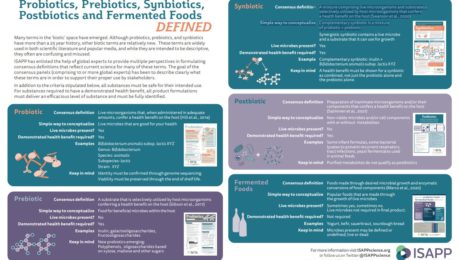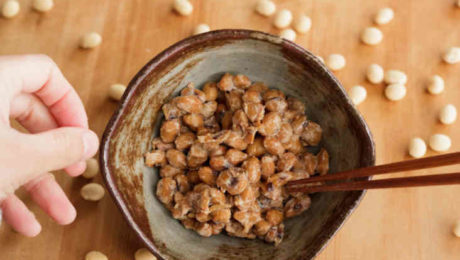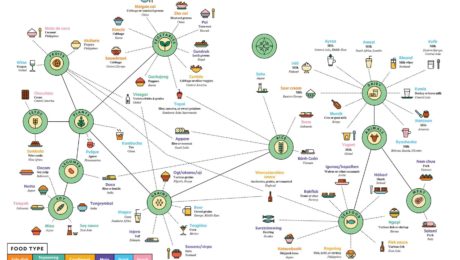Infants Sleep More if Mom Eats Fermented Foods
Toddlers and infants slept 10 hours or more a night if their mother ate fermented foods while pregnant, according to a new Japanese study.
The results, published in the journal BMC Public Health, studied over 64,000 pairs of mothers and their children. The diet of pregnant mothers was found to have an impact on sleep length of their children. Pregnant women who consumed miso, yogurt, cheese and/or natto all had children that slept 10+ hours a night until the age of 3. The article calls it “fermentation for hibernation.”
The study notes, though, that there are other associated factors at play. The women consuming fermented foods were well-educated, employed and had higher incomes compared to the pregnant mothers not regularly consuming fermented foods. Scientists inferred that this higher demographic group “likely recognized factors that could contribute to health and chose nutrient-rich options [instead of] nutritionally-unbalanced food.”
Read more (NutraIngredients)
The Rise of Fermented Foods and -Biotics
Microbes on our bodies outnumber our human cells. Can we improve our health using microbes?
“(Humans) are minuscule compared to the genetic content of our microbiomes,” says Maria Marco, PhD, professor of food science at the University of California, Davis (and a TFA Advisory Board Member). “We now have a much better handle that microbes are good for us.”
Marco was a featured speaker at an Institute for the Advancement of Food and Nutrition Sciences (IAFNS) webinar, “What’s What?! Probiotics, Postbiotics, Prebiotics, Synbiotics and Fermented Foods.” Also speaking was Karen Scott, PhD, professor at University of Aberdeen, Scotland, and co-director of the university’s Centre for Bacteria in Health and Disease.
While probiotic-containing foods and supplements have been around for decades – or, in the case of fermented foods, tens of thousands of years – they have become more common recently . But “as the terms relevant to this space proliferate, so does confusion,” states IAFNS.
Using definitions created by the International Scientific Association for Postbiotics and Prebiotics (ISAPP), Marco and Scott presented the attributes of fermented foods, probiotics, prebiotics, synbiotics and postbiotics.
The majority of microbes in the human body are in the digestive tract, Marco notes: “We have frankly very few ways we can direct them towards what we need for sustaining our health and well being.” Humans can’t control age or genetics and have little impact over environmental factors.
What we can control, though, are the kinds of foods, beverages and supplements we consume.
Fermented Foods
It’s estimated that one third of the human diet globally is made up of fermented foods. But this is a diverse category that shares one common element: “Fermented foods are made by microbes,” Marco adds. “You can’t have a fermented food without a microbe.”
This distinction separates true fermented foods from those that look fermented but don’t have microbes involved. Quick pickles or cucumbers soaked in a vinegar brine, for example, are not fermented. And there are fermented foods that originally contained live microbes, but where those microbes are killed during production — in sourdough bread, shelf-stable pickles and veggies, sausage, soy sauce, vinegar, wine, most beers, coffee and chocolate. Fermented foods that contain live, viable microbes include yogurt, kefir, most cheeses, natto, tempeh, kimchi, dry fermented sausages, most kombuchas and some beers.
“There’s confusion among scientists and the public about what is a fermented food,” Marco says.
Fermented foods provide health benefits by transforming food ingredients, synthesizing nutrients and providing live microbes.There is some evidence they aid digestive health (kefir, sourdough), improve mood and behavior (wine, beer, coffee), reduce inflammatory bowel syndrome (sauerkraut, sourdough), aid weight loss and fight obesity (yogurt, kimchi), and enhance immunity (kimchi, yogurt), bone health (yogurt, kefir, natto) and the cardiovascular system (yogurt, cheese, coffee, wine, beer, vinegar). But there are only a few studies on humans that have examined these topics. More studies of fermented foods are needed to document and prove these benefits.
Probiotics
Probiotics, on the other hand, have clinical evidence documenting their health benefits. “We know probiotics improve human health,” Marco says.
The concept of probiotics dates back to the early 20th century, but the word “probiotic” has now become a household term. Most scientific studies involving probiotics look at their benefit to the digestive tract, but new research is examining their impact on the respiratory system and in aiding vaginal health.
Probiotics are different from fermented foods because they are defined at the strain level and their genomic sequence is known, Marco adds. Probiotics should be alive at the time of consumption in order to provide a health benefit.
Postbiotics
Postbiotics are dead microorganisms. It is a relatively new term — also referred to as parabiotics, non-viable probiotics, heat-killed probiotics and tyndallized probiotics — and there’s emerging research around the health benefits of consuming these inanimate cells.
“I think we’ll be seeing a lot more attention to this concept as we begin to understand how probiotics work and gut microbiomes work and the specific compounds needed to modulate our health,” according to Marco.
Prebiotics
Prebiotics are, according to ISAPP, “A substrate selectively utilized by host microorganisms conferring a health benefit on the host.”
“It basically means a food source for microorganisms that live in or on a source,” Scott says. “But any candidate for a prebiotic must confer a health benefit.”
Prebiotics are not processed in the small intestine. They reach the large intestine undigested, where they serve as nutrients for beneficial microorganisms in our gut microbiome.
Synbiotics
Synbiotics are mixtures of probiotics and prebiotics and stimulate a host’s resident bacteria. They are composed of live microorganisms and substrates that demonstrate a health benefit when combined.
Scott notes that, in human trials with probiotics, none of the currently recognized probiotic species (like lactobacilli and bifidobacteria) appear in fecal samples existing probiotics.
“There must be something missing in what we’re doing in this field,” she says. “We need new probiotics. I’m not saying existing probiotics don’t work or we shouldn’t use them. But I think that now that we have the potential to develop new probiotics, they might be even better than what we have now.”
She sees great potential in this new class of -biotics.
Both Scott and Marco encouraged nutritionists to work with clients on first improving their diets before adding supplements. The -biotics stimulate what’s in the gut, so a diverse diet is the best starting point.
The Stickier the Natto, the Better
Natto significantly lowers levels of both glucose and insulin, according to research by Japan’s National Agriculture and Food Research Organization. Natto, a traditional food in Japan, is a fermented soybean dish valued for its high-nutrient content. It’s characterized by sticky strands that stretch from the dish when stirred and, the research showed, stickier natto is healthier.
Natto’s stringy texture is produced by y-polyglutamic acid (y-PGA), and stickier natto has higher levels of y-PGA. When nondiabetic men and women were fed a series of meals of both high-and low-y-PGA natto, high y-PGA natto “significantly” lowered glucose and insulin levels in the test subjects.
Study results were published in the scientific journal Nutrients. Researchers next hope to “study the long-term health impacts of a diet that includes high γ-PGA natto.”
Read more (Chemical & Engineering News)
Japan’s Rich Culture of hakkо̄
“If there were a country whose cuisine excels in the realm of fermented foods, it’s Japan,” highlights an article in Discover Magazine. In Japan, hakkо̄ (which translates to “fermentation”) forms “the very basis of gastronomy in the island nation,” continues the article.
Tsukemono (pickles), miso (fermented soy bean paste), soy sauce, nattо̄ (fermented soy beans), katsuobushi (dried fermented bonito flakes), nukazuke (vegetables pickled in rice bran), sake and shōchū (liquor distilled from rice, brown sugar, buckwheat or barley) are all staples of traditional Japanese meals.
Nattо̄ in particular has been proven to lower obesity rates, boost levels of dietary fiber, protein, calcium, iron and potassium and reduce diastolic blood pressure.
Though the article highlights the few, limited studies on the effects of other fermented foods, it also noted how difficult it is to study them. There little money behind the study of traditional foods (outside of yogurt), and participants in any such research would need to be on the same diets and exercise programs in order to produce objective results. A study would also need to take place over multiple years — “the cost would be vast, the ethics questionable.”
Read more (Discover Magazine)
- Published in Food & Flavor
Natto Stops Covid-19?
Natto — the sticky, slimy fermented soybeans, commonly eaten in Japan — inhibits infection by the coronavirus, according to the Tokyo University of Agriculture and Technology (TUAT). Researchers found that natto contains extracts that break down proteins on the surface of the coronavirus, preventing it from infecting cells.
Their results, published in the journal Biochemical and Biophysical Research Communications, note further studies are needed to determine if there are antiviral properties in the food. But the trial found natto also limited infection by Bovine herpesvirus-1 (BHV-1), a cause of outbreaks of respiratory disease in cattle around the world.
Important to note: the study was funded by Takano Foods Co., Ltd., a Japanese company that makes natto commercially.
Read more (Biochemical and Biophysical Research Communications)
Trends in Pandemic Eating
Consumers increasingly embraced adventurous and healthy food over the last twelve months, but “a big pandemic winner is fermented foods.”
An article from the Associated Press details how, now a year into isolation, people are cooking beyond comfort food. They’re “embracing foods long forgotten or rejected for taste, texture or smell.” Anne Alderete (pictured) details how she is finally enjoying natto (fermented soy beans) after rejecting it for years.
Read more (Associated Press)
- Published in Food & Flavor
The World of Fermented Foods
In the latest issue of Popular Science, a creative infographic illustrates “the wonderful world of fermented foods on one delicious chart.” It represents “a sampling of the treats our species brines, brews, cures, and cultures around the world,” and is particularly interesting as it shows mainstream media catching on to fermentation’s renaissance. Fermentation fit with the issue’s theme of transformation in the wake of the pandemic.
Read more (Popular Science)
- Published in Food & Flavor
Korean Flavors Hot in America in ‘21
Korean flavors are becoming more mainstream. Already popular with American diners is the Korean staple kimchi. But food experts predict two less common Korean favorites will soon become a part of American’s diets. Gochujang (fermented red pepper chili sauce) and doenjang-jigae (stew made with fermented soybean paste) will be 2021’s next food trend.
Read more (Forbes)
- Published in Food & Flavor
Retail Sales Trends for Fermented Food and Beverage
Kimchi, fermented sauces and tempeh are driving growth in the fermented food and beverage category, a $9.2 billion industry that’s grown 4% in the last year.
“We’re excited about the growth potential for fermented food. While fermented food represents about 1.4% of the market today, there are segments that are tracking well above the growth of food and beverage [overall] that are poised for disruption in the future,” says Perteet Spencer, vice president of strategic solutions at SPINS. Spencer shared this information in a recent webinar hosted by The Fermentation Association. “There’s a ton of opportunity to scale and increase the footprint of these products.”
SPINS spent weeks working with TFA to define the fermentation industry’s sales, drilling into 10 fermented product categories and 57 product types. Wine, beer and cheese sales were excluded from the data — those categories are very large, and would obscure trends in smaller categories. (All three are also well-represented by other organizations.)
Pickles and fermented vegetables “is a space that’s seen [a] pretty explosive uptick in growth over the past year,” Spencer says. Every segment is growing — kimchi, sauerkraut, beets, carrots, green beans, sliced and speared pickles and all other vegetables — with pickles the largest, nearly 60% of the category.
The biggest growth, though, is coming from products other than pickled cucumbers. Kimchi is at the center of numerous consumer retail trends. Consumers are purchasing healthier food made with fewer ingredients, and they want food with international flavors. Kimchi makes up only 7% of the category, but sales are increasing at an explosive 90% growth rate.
More people are experimenting with fermenting while they’re at home during the coronavirus pandemic, but these kitchen DIYers do not appear to be detracting from sales.
“The more people make fermented foods, they appreciate what’s available in the store that maybe didn’t exist five or 10 years ago,” notes Alex Lewin, author and TFA advisory board member who moderated the webinar. “Anyone who has made kimchi knows it takes a lot, it makes a big mess, you get red pepper powder stuck under your fingernails and onion in your eyes. I can make kimchi (at home), and then once I’ve made kimchi, I’m like ‘Ok, maybe next time I’ll buy it.’”
Fermented sauces are also growing, up 24% in 2020. The largest segment in sauces is, of course, soy sauce, almost 85% of the category. But gochujang, less than 2% of the category, is increasing at over a 56% growth rate.
Versatility is helping sauces, pickles and fermented vegetables, Spencer says. Any food product with multiple uses is selling well. The condiments and sauces can be used as a topping on eggs, hamburgers or pizza, or mixed-in a salad, rice dish or soup.
Sake, plant-based meat alternatives and miso had combined annual growth of $75 million in 2020. Sake grew 16%, and both plant-based meat alternatives and miso each grew 26%.
Yogurt and kombucha still dominate the fermented food and beverage market. Yogurt is 81% of the market; if yogurt is removed, kombucha is 51% of the remainder.. Both have experienced slowdowns in sales from their peaks. Kombucha sales have slowed recently, as grab-n-go opportunities have shrunk during the pandemic.
Yogurt giant brands Chobani, Yoplait and Dannon still dominate the category, as do GT Kombucha, Health-Ade and Kevita reign for kombucha.
Spencer notes the 4% growth rate of fermented products overall would be higher without yogurt. It’s a large category that — despite an uptick in 2020 during the pandemic – has been fairly flat in recent years. Core (traditional) yogurt has been growing at a 1.6% rate; Greek yogurt, at about twice that pace. Those two segments account for roughly 80% of the category.
“This is an opportunity for disruption for emerging brands,” Spencer says. “We’re already seeing some of the legacy segments start to get disrupted by new innovation, so I’m excited to see the evolution of that innovation and where that goes and kind of what opportunities peek out of that.”
“Overall, we’re seeing historically small segments gaining traction in the marketplace,” Spencer adds. “The pandemic has brought a renewed consumer focus on the fermented space.”
Though fermented products have an added healthy benefit, customers are looking for delicious flavor first.
“In these fermented categories we covered today, taste first is always really important. I think people are going to these categories for different taste experiences,” Spencer says. “If you can level up with a functional benefit, that’s fantastic, but we have to balance the taste first. If it’s highly functional but doesn’t taste good, it just doesn’t have the same success.”
- Published in Business
- 1
- 2










